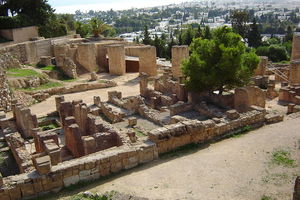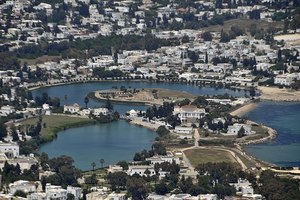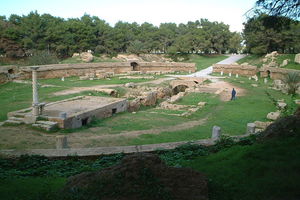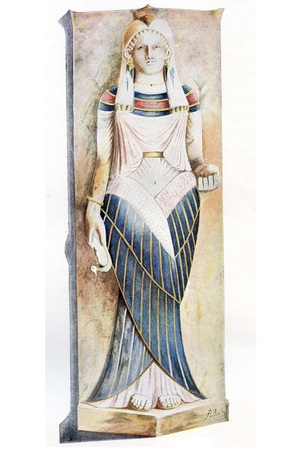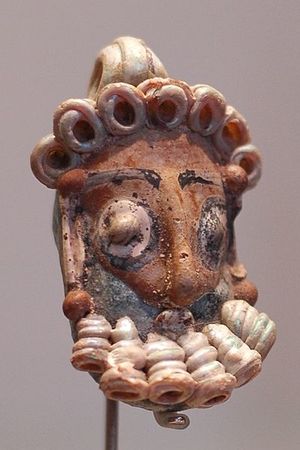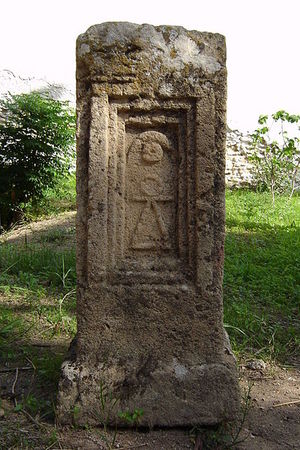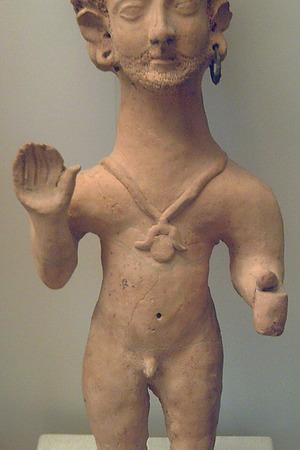Punics
The Punics, Carthaginians or western Phoenicians, are a group of peoples in the western Mediterranean who traced their origins to the Phoenicians who migrated to North Africa and established colonies there in the 12th-7th centuries BC, such as Utica, Carthage, Leptis Magna, and others. In modern science, the term "Punic" - a Latin equivalent of the Greek derivative term "Phoenician" - is used exclusively to denote Phoenicians in the western Mediterranean, following the line of Greek East and Latin West.
They mainly consisted of the inhabitants of ancient Carthage (modern Tunisia), as well as those Phoenician colonists who acknowledged Carthaginian leadership in other parts of North Africa, western Sicily, southern Sardinia, Malta, Ibiza, and southern Spain. Their language, Punic, was a dialect of Phoenician.
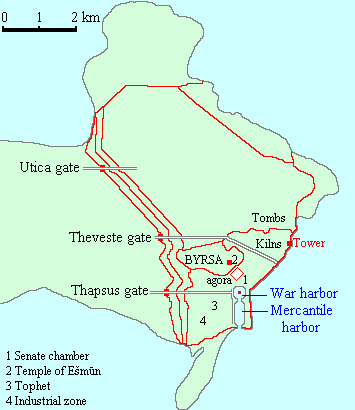 Layout of Ancient Carthage before the 3rd Punic War
Layout of Ancient Carthage before the 3rd Punic War
The first Phoenicians settled in the western Mediterranean in the 12th century BC and became part of trade networks associated with Tyre and Sidon in Phoenicia. Although connections with Phoenicia were maintained throughout their history, they also developed close relationships with other peoples of the western Mediterranean and developed cultural features distinct from their ancient Phoenician homeland. Some of these were common to all western Phoenicians, while others were limited to individual regions within the Punic sphere.
The Western Phoenicians were organized into numerous self-governing city-states. Carthage became the largest and most powerful of these city-states by the 5th century BC and gained increasing control over Punic Sicily and Sardinia in the 4th century BC, but other communities remained outside their control. During the Punic Wars (264-146 BC), the Romans challenged Carthaginian hegemony in the western Mediterranean, culminating in the destruction of Carthage in 146 BC, but the Punic language and Punic culture survived under Roman rule, surviving in some places until Late Antiquity.
In the 560s BC, royal power in Tyre was abolished. All Phoenician colonies fell under the control of the Carthaginian Empire.
Carthage
Carthage (Phoenician: 𐤒𐤓𐤕𐤇𐤃𐤔𐤕, Qart-ḥadašt, Latin: Carthago, Arabic: قرطاج, Carthage, French: Carthage, Ancient Greek: Καρχηδών) is an ancient city (museum) located on the eastern shore of Lake Tunis in modern Tunisia, near the city of Tunis. Carthage was the most important trading center of the ancient Mediterranean and one of the richest cities of antiquity.
The name Qart-ḥadašt (in the Punic notation without vowels Qrt-ḥdšt) translates from the Phoenician language as "new city".
Throughout its history, Carthage was the capital of the Carthaginian state, founded by the Phoenicians, which dominated a significant part of the southwestern Mediterranean during the first millennium BC. The Tyrian princess Elissa or Dido is considered the founder of the city, although her historicity has been questioned. According to the records of Timaeus of Taormina, Dido was forced to leave her homeland; upon arrival on the shores of modern Tunisian Bay, she decided to buy land from local tribes to establish a city. She was allowed to buy only as much land as a bull's hide would cover. Then Dido took and cut the bull's hide into thin strips, fenced a steep coastal hill with them, where she built a fortress known as Byrsa. It is from this fortress that the history of Carthage begins. Having developed, it founded an empire and began to claim power in the region, which became the only existential threat to Rome until the arrival of the Vandals several centuries later.
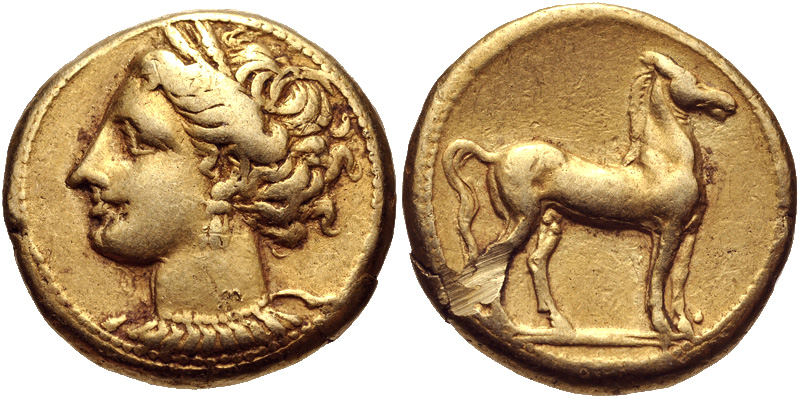 Carthaginian coin depicting the goddess Tanith (c. 310-290 BC)
Carthaginian coin depicting the goddess Tanith (c. 310-290 BC)
Carthage is located on the African coast of the Mediterranean Sea, approximately ten kilometers east of the modern city of Tunis in northern Tunisia. The city is situated on a peninsula, bordered by the Gulf of Tunis to the east, the lagoon of Lake Ariana to the north, and Lake Tunis to the south. Carthage was located on a major Phoenician trade route between the Levant and Gibraltar. Its position on the Sicilian Strait allowed it to control maritime trade in the Mediterranean Sea. This was the main reason for the city's economic and military dominance. At the same time, there was a connection between Sicily and the Tyrrhenian Sea and the northern Mediterranean. The city had two large artificial harbors, one for accommodating a huge fleet of 220 warships, and another for commercial trade. A walled tower overlooked both harbors. The city had massive walls measuring 23 miles (37 km), which was more than the walls of comparable cities. Most of the walls were located along the coast and therefore may have been less impressive, as Carthaginian control of the sea hindered attacks from that direction. About 3 miles (4.8 km) of walls on the western isthmus were truly massive and were never breached. The location was strategically advantageous as it allowed for easy defense of the city from land. North of the actual urban development, but still within the city walls, was the agricultural district of Megara in ancient times.
According to legend, Queen Dido, who fled to these lands from Tyre after her brother, King Pygmalion, killed her husband Sychaeus, decided to buy land for the foundation of the city. She was allowed to buy as much land as she could cover with a bull's hide. The resourceful queen cut the bull's hide into thin strips, tied them together, and used the resulting long rope to mark her possessions. Not coincidentally, the citadel that emerged in the center of Carthage was named Byrsa, which means "hide." Carthage (Qart-ḥadašt) literally means "new city." It was "new" primarily in relation to the neighboring Utica (whose name, accordingly, translates as "old city"), but some researchers understand the name as "new Tyre." The Carthaginians were Phoenician settlers originating from the Mediterranean coast of the Near East. They spoke Canaanite languages, a Semitic language family, and followed a local variant of the ancient Canaanite religion. The Carthaginian Republic was one of the longest-lived and largest states in ancient Mediterranean.
In 814 BC, Elissa committed suicide (according to legend-thus destroying the plans of the Berber leader of the Maxitan tribe Iarbant to marry her and get the city as a "dowry"), and an aristocratic republican system was established in Carthage. The highest authority in the city belonged to the Council of Ten (Asharat) - first consisting of Dido's companions, and then of their descendants. There were also people's assemblies (Ams), but almost nothing is known about their powers, which may indicate that their influence was insignificant. The commander of the army (rabimahanate) was appointed by Asharat, and it was he who represented Carthage in foreign relations. Unlike Rome, where the leading position was occupied by the Senate, where the best people were elected, in Carthage a more significant role was assigned to the people's assembly. But some scholars believe that the real power in the city was held by the oligarchs, a group of particularly wealthy individuals. Carthage, along with Rome, was considered the most cultured and developed city of that period.
By the beginning of the 3rd century BCE, Carthage had become the largest state in the western Mediterranean. Its location between Sicily and the coast of present-day Tunisia allowed it to control the ships that passed by. In those times, ships typically sailed within sight of the coast. In the first quarter of the 7th century BCE, a new wave of settlers from Phoenicia arrived in Carthage. The city grew rapidly, establishing trade connections not only with the metropolis and other Phoenician colonies but also with Etruria and Greece, particularly Corinth. In 663 BCE, the Carthaginians founded their first colony, Ebusus, on the Pityusic Islands off the Spanish coast. The Carthaginian expansion into the far west of the Mediterranean Sea led to a conflict with Massalia, which considered those territories its own "homeland." The Carthaginians suffered defeat and were forced to focus primarily on the development of the African coast. Thus, in the late 7th and early 6th centuries BCE, Kerkouane was founded on the Bon Peninsula, and control was established over Hadrumetum, Sabratha, and Leptis Magna.
 The Carthaginian shekel, dated 237-227 BC, depicting the Punic god Melkart (equivalent to Hercules)
The Carthaginian shekel, dated 237-227 BC, depicting the Punic god Melkart (equivalent to Hercules)
The Carthaginians were a warlike and industrious people. They dug two harbors (cothons) on the coast, one for warships, which could accommodate approximately 220 vessels, and another for trade. In addition, they built a fortified wall around the entire city, with a total length of 37 km and a height reaching 12 m in some places. Carthage became impregnable from land and sea, guarded by warships. The city itself was divided into four residential districts. It had a cemetery for burials and dedicated cult places for worshiping the gods, where sacrifices were made.
The Carthaginians sailed to various places and subjugated southern Spain, lands in North Africa, and the islands of Sicily, Sardinia, and Corsica. The Romans referred to the Carthaginians as Punics. Initially, both states assisted each other in military actions, but soon friction arose due to the possession of Sicily, as well as influence in other lands and seas.
Related topics
First Punic War, Second Punic War, Third Punic War

 Gallery
Gallery






 Image of a Carthaginian woman on a marble sarcophagus. The image could have belonged to a priestess, princess, or goddess. 3rd century BC
Image of a Carthaginian woman on a marble sarcophagus. The image could have belonged to a priestess, princess, or goddess. 3rd century BC
